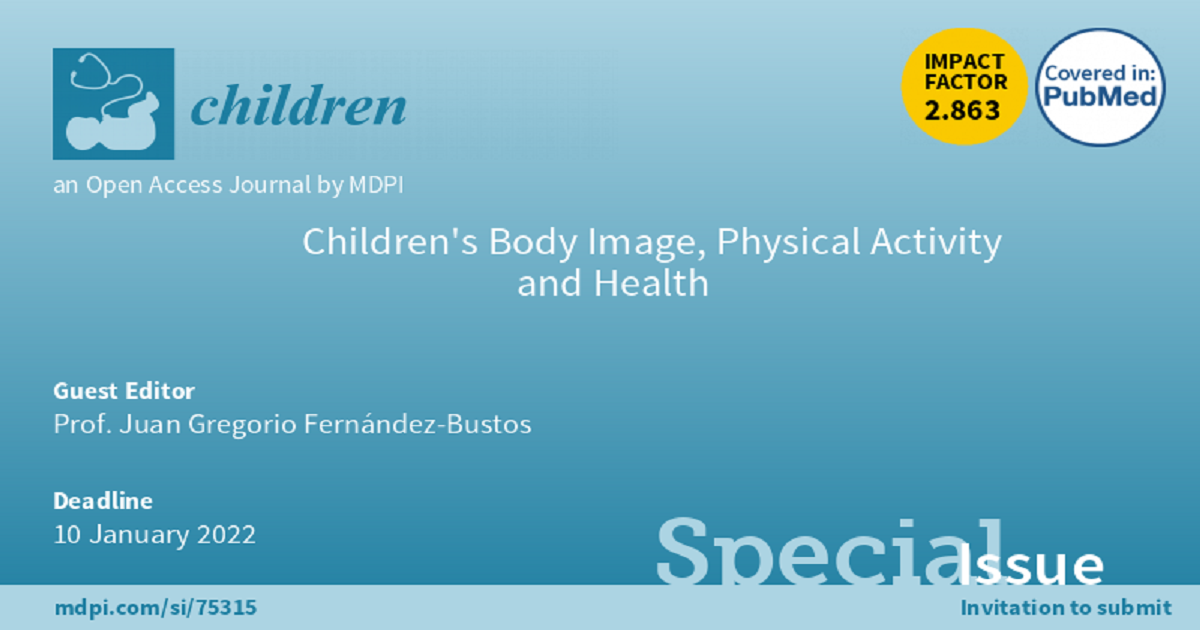Children's Body Image, Physical Activity and Health
A special issue of Children (ISSN 2227-9067). This special issue belongs to the section "Global and Public Health".
Deadline for manuscript submissions: closed (10 January 2022) | Viewed by 18187

Special Issue Editor
Interests: body image; physical appearance; children’s mental health; children’s social health; physical activity and health; physical self-concept
Special Issue Information
Dear Colleagues,
Body image (BI) is a multifaceted concept that refers to individuals’ perceptions and attitudes about their own body. BI is especially relevant in children and adolescents due to the importance of everything related to the body at these ages. BI has traditionally been associated with various indicators of physical, mental, and social health. Regarding mental health, a negative BI is associated with depression and low self-esteem. On the one hand, body dissatisfaction has prospectively been linked to unhealthy behaviors such as poor nutrition, low levels of physical activity, weight control behaviors, and even eating disorders among children and adolescents. Furthermore, body dissatisfaction has also been associated with peer relationship problems, avoidance behaviors, and social isolation. On the other hand, having a positive BI entails protective effects such as a higher self-esteem, a greater psychological well-being, an engagement in self-care behaviors and physical activity, and better social health.
Therefore, there is a clear need to deepen our understanding of BI and its relationship with different health fields, as well as to work on an early prevention of BI-related issues during childhood, since this is a stage in which a positive approach to BI must prevail. Furthermore, researchers suggest that programs aimed at promoting healthy BI are more likely to be effective when carried out in preadolescence or even at younger ages, since individuals’ attitudes and behaviors have not been established yet. Similarly, an issue of special interest is how physical activity influences BI. Much of the literature has focused on testing how physical activity is associated with a more positive BI, although this has not been deeply researched in children.
The Special Issue on “Children’s Body Image, Physical Activity and Health” aims to gather all research that studies BI in children, especially from a positive approach, and its associations with any of the health fields (i.e., physical, mental or social). It also intends to deeply examine the role of physical activity on building a positive BI. Original quantitative or qualitative research, systematic reviews, as well as case reports that could extend the knowledge in this field are welcome.
Prof. Juan Gregorio Fernández-Bustos
Guest Editor
Manuscript Submission Information
Manuscripts should be submitted online at www.mdpi.com by registering and logging in to this website. Once you are registered, click here to go to the submission form. Manuscripts can be submitted until the deadline. All submissions that pass pre-check are peer-reviewed. Accepted papers will be published continuously in the journal (as soon as accepted) and will be listed together on the special issue website. Research articles, review articles as well as short communications are invited. For planned papers, a title and short abstract (about 100 words) can be sent to the Editorial Office for announcement on this website.
Submitted manuscripts should not have been published previously, nor be under consideration for publication elsewhere (except conference proceedings papers). All manuscripts are thoroughly refereed through a single-blind peer-review process. A guide for authors and other relevant information for submission of manuscripts is available on the Instructions for Authors page. Children is an international peer-reviewed open access monthly journal published by MDPI.
Please visit the Instructions for Authors page before submitting a manuscript. The Article Processing Charge (APC) for publication in this open access journal is 2400 CHF (Swiss Francs). Submitted papers should be well formatted and use good English. Authors may use MDPI's English editing service prior to publication or during author revisions.
Keywords
- Body image
- Body appearance
- Body self-concept
- Children
- Health
- Mental health
- Social health
- Physical activity






